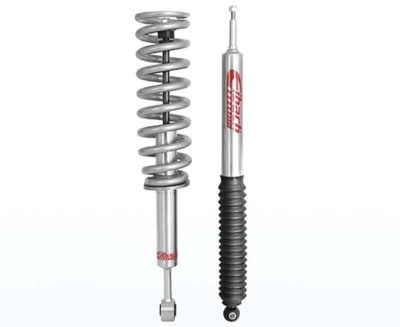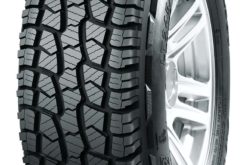Choosing the Right Lift Kit


There are so many responsible ways to spend a paycheque. Rent, groceries, student loans, and general savings all come to mind, yet none of those options are really top of mind for a true automotive enthusiast.
“I don’t want a mean-looking rig equipped with a few inches of beefy lift, high-performance shocks, and a set of aggressive wheels and tires to match,” says, umm, no one. Just as a gearhead will always find spare coins for speed and performance parts, a truck and off-road admirer will bust the piggy bank to install a stylish new mod.
Today’s focus: Taking a plunge into the complexities of suspension—because investing a few hundred to a few grand is obviously the smarter way to spend a paycheque, right? “Beyond looking cool, the main reason to lift a truck is to gain clearance and get the body, frame, and differentials higher. Installing bigger tires is how you do that, and the only way to fit them is to lift the truck,” explains Benjamin Jerew in a feature titled, Lifting a Truck’s Suspension — Why, How and Whoa! As Jerew educates on NAPA’s Know How Blog:
- Off-roading is easier with a lifted truck because of its increased approach, breakover, and departure angles. The taller tires boost differential clearance, and the lifted suspension keeps all four wheels on the ground for maximum traction.
- Visibility is also better in a lifted truck. After all, you can see much farther down the road.
- Finally, towing and hauling can be easier in a lifted truck because the suspension has more room to settle before bottoming out under the load.
Suspension upgrades range from average to extreme, and affordable to expensive, so finding the ideal lift can be intimidating and overwhelming. Evaluating the intended purpose of one’s truck should be of utmost consideration. Everything else stems from this decision, even budget. The owner of an off-road-ready truck has vastly different needs in comparison to a daily driver, or someone whose main purpose is to haul large payloads or tow heavy machinery and a trailer filled with weekend powersports toys.
Additionally, rushing into a decision could prove disappointing and expensive. It is wise to review local suspension regulations for on-street and off-road driving since some changes to a suspension system could put a truck owner in violation.
Furthermore, “Lifting your truck might look cool and come with some benefits, but a lifted truck isn’t the same after you’ve significantly changed the parameters of its operation,” Jerew reminds. All modifications have some effect on driving experience, but especially suspension.
This is not a modification that should be made in haste. 4×4 Off-Road Network in Northern Colorado states in jest, “It’s going to handle differently in inclement weather on typical paved roads, and the highway will chew through your tires in the form of uneven wear and tear. And did I mention how loud those tires are, and the fact that they just don’t ride like a dream once that suspension lift goes in?”
Suspension upgrades alter a truck’s centre of gravity, which can affect the comfort and ease of handling. Likewise, as a truck gains height, it is at a greater risk of rolling while cornering. Depending upon the aftermarket suspension of choice, other modifications may need to be completed as well. New shocks and longer brake lines may be required, or even driveshaft extensions or an upgraded sway bar or traction bars to relieve stress on components or maintain stability. Don’t forget fuel efficiency—as those bigger tires and wheels, along with the suspension kit itself, all add significant weight. And one can’t discount the convenience factor.
An all-new Ram 1500 lifted in all its glory may illicit heart-pounding delight when pulling up to the curb, but bigger, taller trucks also pose increased difficulty for that pretty date of yours who is struggling to climb in and out, even with the assistance of steps and running boards by trusted names like Dee Zee, TrailFX, and Westin.
Now that all disclaimers are out of the way, it is time for an education in choices, specifically investing in a level kit versus a suspension lift kit. “Leveling kits, in general, lift the front end of the vehicle to correct stance and provide some additional clearance for wheels and tires,” states Mark Williams, author of The Engine Block’s Tech Corner: Consider THIS Before DIYing Your Suspension Kit.
“Depending on the truck, this is done with either torsion bar keys or spacers placed within the suspension itself. Sometimes, the lift can be achieved through other methods. But generally speaking, the job isn’t an overly complicated task. Most anyone who can turn a wrench can take this on at home, provided they have the appropriate tools for the job,” he adds.
A leveling kit can give a truck 2.5 inches of additional space, accommodating 33-in. all-terrains. In addition to an easy installation, Auto Anything notes they are far less expensive in comparison to a full suspension lift kit. Its website has a helpful breakdown of brand and product selection, as shown below:
- Airbag kits – Air Lift Air Bag Suspension Kit
- Coil spacer kits – ReadyLIFT Leveling Kits
- Coilovers – Rancho QuickLIFT Loaded Leveling Struts
- Lifting coil springs – Eibach Lift Kits
- OEM replacements – Bilstein B8 5100 Truck, Jeep & SUV Shocks
- Rear block kits – ReadyLIFT Rear Block Kits
- Torsion key kits – ProRYDE Duck Head Torsion Keys

He reminds readers the greater the lift, the more complex the job. It is important to keep in mind that, often times, additional modifications are required with a suspension lift kit. Consumers will likely require larger tires and wheels to accommodate the lift of choice (a purchase no one is crying over…), longer shocks, as well as other components to correct driveline and alignment angles or brake line lengths.
“This is because the further the suspension is lifted, the more other factors—like the geometry of the powertrain or the suspension components—are impacted. Transfer cases and differentials may need to be lowered, and control arms and shocks may need to be replaced with longer units. Almost all lift kits that consequently affect these areas will provide customers with the necessary components to make things work, but it can add a substantial amount of time and difficulty to the process,” he adds. Again, the Auto Anything website does a great job at presenting consumers with brand and product selection:
- Body lift kits – Pro Comp Lift Kit
- Coil spacer kits – Daystar Comfort Ride Lift Kits
- Lifting coil springs – Tuff Country Lift Kits
- Lifting leaf springs – ReadyLIFT Off Road Lift Kit
- Rear block kits – TruXP Performance Block Kits
Respectable companies stand behind their products. TrailFX, for example, backs its suspension components with a very generous 5-year—60,000-mile X-GUARD Plus Powertrain warranty that covers both the product and all major powertrain parts, so customers can enjoy their vehicle modifications with peace of mind.
The takeaway here: Educate yourself, do not make rash decisions that could cost you time and money down the line, and quality brands and products matter.














